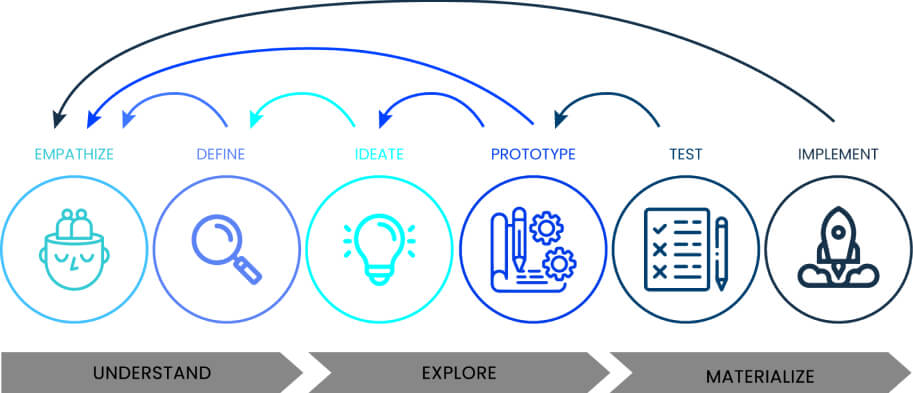More and more organizations are choosing to take a human-centric approach to evolve their existing products/services, and to keep generating new ideas that are of benefit to their customers. The most commonly known human-centered methodology is design thinking, a process used to solve problems by prioritizing people’s needs above all else.
This is mainly based on observing and understanding, with empathy, how people interact with their environments (physical or digital), using an interactive and practical methodology that allows us to create innovative solutions that really respond to user needs.
How does it work?
The design thinking process focuses on “understanding” the end-users and their needs, “exploring” conceptual solutions based on those needs, and “realizing” the solution to optimize the result.

Some of its main features are:
– The order in which each phase is executed can be altered and become cyclical instead of strictly linear. In turn, the steps can be adapted, modified, and adapted as required.
– Openness to continuous iteration, it is common to return to previous phases after progress has been made and an initial prototype has been built and tested.
– Translating ideas into workable prototypes to get a true representation of your design and understand in real-time how end users are interacting with it.
¿Design thinking in Salesforce?
The key question is how design thinking relates to the Salesforce ecosystem. Believe it or not, in your day to day you currently make use of the process even if it is unconsciously.
Design thinking proposes a flexible way to think and proceed in different situations.
When choosing a design for the user interface (UI), when structuring newsletters and newsletters for the experiences of your employees and customers (UX), when aligning the inputs with the color palette of the brand (graphic design), there are several tasks you perform that are linked to this type of design thinking. Most likely some of these decisions and actions have become automatic steps within your workflow.

Here are some of the reasons why you should start implementing design thinking in your Salesforce ecosystem:
1. Identify and understand users
Empathy is the ability to understand someone else. By generating empathy with your internal users, the team members, you can constantly improve your processes to produce better results in sales, leadership, and finance. The same is true when we put ourselves in the shoes of our external users, the customers, to find out which features, products, or services they use and need the most, and why. Empathy ends up becoming the greatest factor of trust of our users with us. This is known as human-centered design (HCD).
HCD is the creative approach used to solve people’s problems, starting with identifying their needs and ending with creating solutions (products, experiences, and services) that meet those needs. Strengthening our processes, products and services around HCD is a key way to better understand the human component inside and outside the organization.
2. Define the business challenge
After evaluating the needs of the organization and the needs of its users to form an objective, we must define the problem that we are going to address to establish the key performance indicators. People don’t just buy products or services. Instead, they “hire” a product or service to get ahead in specific circumstances. When the “job” is clear, what you do can be further tailored to meet and exceed the need.
When the problem is clear, teams can pool their efforts to come up with the best possible ideas.
3. Ideate until you find the solution
If you have ever imagined or conceived a new idea, then you are already familiar with the ideation process. In design thinking, this is usually presented as brainstorming done independently or in conjunction with others. This is based on answers to How Might We (HMW) questions. These questions help us transform problems into opportunities.
That’s when ideas become reality.
4. Prototype the solution
Preliminary versions of an idea help us bring the right product or service to market faster. Something very important to consider is that our first versions do not have to be aesthetically attractive, what interests us visually is to reflect functionality and purpose, and after having it clear we can worry about aesthetics.
The idea is real and becomes even more real when visualized.
5. Test the solution
With our prototype created, we can proceed to pass it to production. Briefly: we are moving from design thinking to design doing. In the realization part, look for repeatable design solutions to recurring problems. In this way, you will obtain the design patterns that will help you lay the foundation for your system and its components.
Now that it’s active, let’s see how it works.
6. Validation is built into function
As an organization, we have a responsibility to deliver products and services that meet the required quality, performance, and reliability. That is why it is important to put our prototypes to the test. To do this we may share beta versions with a subset of users to allow them to test the features first and get their feedback. By doing this, we create reports, chats, and forms that reveal insights that lead to optimizations.
Salesforce gives companies the freedom to design specific experiences for their customers, adding the design thinking approach can improve our ability to come up with solutions faster, with more ideas, and to validate that we are truly delivering the right digital experience for their customers.
By engaging leaders, customers, workers, and partners in the process of establishing key issues and supporting future state solutions, you get a more accurate representation of what will drive them to use the new system day in and day out for personalized experiences that exceed Your expectations. Interested in implementing design thinking in your Salesforce ecosystem? Contact us and let’s start working together!
Aileen Velis
Strategic Designer
Aileen Velis is a strategic designer and part of the Digital Partner marketing team. She is passionate about design methodologies and her pets. She is a lover of constant challenges and is a closset illustrator.


